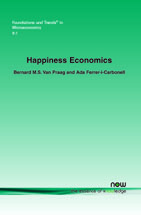Happiness Economics: A New Road to Measuring and Comparing Happiness
By Bernard M. S. Van Praag, University of Amsterdam, The Netherlands, b.m.s.vanpraag@uva.nl | Ada Ferrer-i-Carbonell, Universitat Autònoma de Barcelona, Spain, ada.ferrer@iae.csic.es
Abstract
This paper deals with the concept of happiness in economics. Of late there has come into life a branch of happiness economics and it is this field that will be our concern. Actually, not only economists are interested in quantifications of happiness but also researchers in other disciplines. Notably there are several psychologists who investigate happiness as well. We mention Schimmack et al. (2002), Kahneman et al. (1999, 2006), Kahneman and Krueger (2006), Clark et al. (2008) and Lucas and Schimmack (2009). There are also some interconnections between happiness economists and psychologists as in the citations just mentioned. In this paper we will focus on happiness economics, although we will sometimes refer to work in other disciplines as well. Happiness economics is up to now an empirically oriented field. There is no attention for philosophical contemplations on happiness, the sense of life, etc. as we find in philosophy and religious studies (see, e.g., Feldman (2010), Nussbaum and Sen (1993), Haybron (2010) and Bok (2010) for a philosophical approach). We shall not touch on these issues in this tract.
Happiness Economics
HAPPINESS ECONOMICS deals with the concept of happiness in economics. Most economists until recently were very suspicious about happiness economics and the common opinion was that happiness is not empirically measurable. Actually there is now a growing body of serious economists who are willing, either reluctantly or wholeheartedly, to include happiness economics as a part of economic science. For a better understanding of happiness economics, the authors examine the viewpoint of mainstream economics in the introduction. Section 2 starts by considering the methods of analysis in happiness economics. Section 3 considers life satisfaction (or happiness), section 4 considers domain satisfactions, section 5 returns to the ordinality-cardinality question, and Section 6 provides the link between domain satisfactions and satisfaction with life as a whole. Section 7 considers the work of the Leyden school that may be seen as a forerunner of modern happiness economics. Section 8 considers the effect of the individual's reference group on her or his happiness. Section 9 examines the influence of past events and the anticipated future on present life satisfaction. Section 10 deals with the effect of climate and more generally of the external environment on satisfaction. Section 11 considers the effect of inequality on individual happiness and considers happiness inequality per se. Section 12 considers how the vignette approach, so popular in marketing, can be applied in happiness economics. Section 13 delineates the significance of happiness economics for normative economics. And Section 14 draws some conclusions and discusses the relevance of the new findings for economic science and the social sciences in general.
